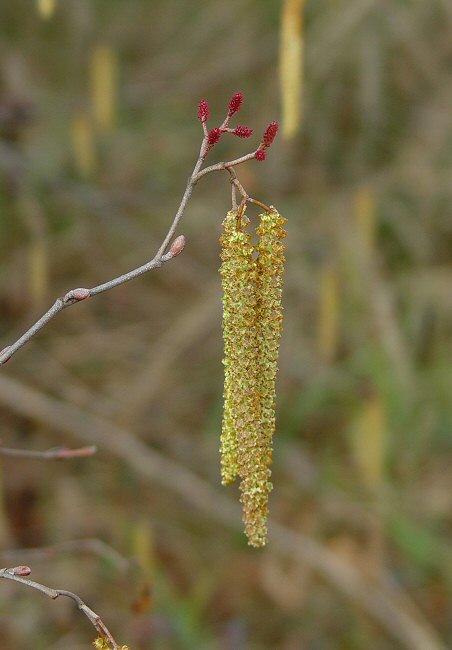Alnus serrulata (Aiton) Willd.
Common Alder

Native
CC = 7
CW = -5
MOC = 39
© DETenaglia
Alnus serrulata (Aiton) Willd.Common Alder | |
 |
Native CC = 7 CW = -5 MOC = 39 |
© DETenaglia |
|
Family - Betulaceae Habit - Shrubs or small trees to 3 m tall, monoecious. Stems - Young growth (twigs, leaves, and inflorescences) with a sticky or resinous coating. Twigs 1.5-2.0 mm thick, dark purplish brown, usually hairy, the pith more or less triangular in cross-section. Buds stalked, with 2 or 3 scales. Bark light gray, smooth. Buds on twigs 4-5 mm long (excluding stalk), with 2 or 3 scales.
Leaves - Alternate, petiolate. Petioles to 18 mm long. Leaf blades elliptical to rhombic, 5-13 cm long, 3.0-7.5 cm wide, the base rounded to narrowed, the tip broadly or bluntly pointed to rounded, the margins finely toothed, the teeth 0.2- 0.5 mm long, each side of the midrib with 7-11 strong secondary veins, the lower surface hairy along the veins.
Inflorescences - Staminate and pistillate flowers in separate catkins. Flowers - Corollas absent in staminate flowers. Stamens 4. Pistillate flowers with calyces rudimentary or absent; corollas absent; ovary inferior, with 2 locules toward the base but often appearing 1-locular toward the tip, the placentation axile. Styles 2, each with a linear stigmatic region toward the tip.
Fruits - Conelike infructescences 1-2 cm long, the fruits 2.5-4.5 mm long (including the styles), narrowly winged.
Flowering - March - April. Habitat - Along streams and streambanks, spring branches, wet meadows, pond margins, often partially submerged. Origin - Native to the U.S. Lookalikes - A. glutinosa Other info. - This is the only native species of alder in the state of Missouri. The plant can be found mostly in the southern half of the state but also along the Mississippi River. Beyond Missouri, its range extends southward, eastward, and up into New England. A. serrulata is a shrubby tree which grows to a few meters tall and has multiple stems from its base. It is a very early-flowering species, with the flowers appearing well before the new leaves. The leaves of the plant stay green well into the winter before becoming brown and falling. Natives used a tea made from the bark to treat diarrhea, coughs, toothaches, sore mouth, and to lessen the pain of childbirth. The tea was also used as a wash for poison ivy. Settlers used the tea as a treatment for malaria and syphilis. Alders have root nodules which enrich the soil by nitrogen fixation: converting nitrogen from the air into a form usable for plant growth. Photographs taken off Lee Rd 54, Auburn, Alabama., 1-23-06 (DETenaglia); also at Taum Sauk State Park, Iron County, MO, 8-4-2020 (SRTurner). |